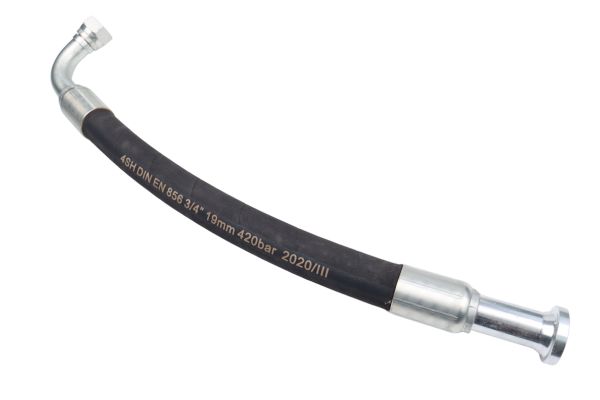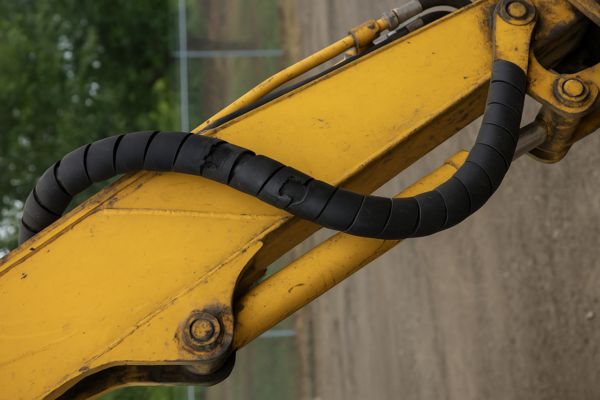A sudden hose failure is more than an inconvenience; it’s a safety hazard and a productivity killer. This guide dissects the root causes of hose damage, from manufacturing flaws to operational errors, empowering you to maximize lifespan and prevent costly downtime.
The Flaw Within: Manufacturing and Material Defects
Not every hydraulic hose leaves the factory equal in quality. While operator mistakes often get the blame, sometimes a hose is doomed from the start. Manufacturing defects and material flaws can silently shorten its life — even before the first drop of fluid flows through it.

Inconsistent Wall Thickness
One of the most common hidden defects is uneven wall thickness in the hose’s inner tube or outer cover.
A thinner section becomes a weak point, where pressure concentrates during operation. Even when used within its rated limits, that spot can bulge, blister, or burst.
Faulty Wire Reinforcement
The steel wire reinforcement is the backbone of a high-pressure hose. It determines both its strength and flexibility.
When the wire is:
- Braided too loosely, the hose expands excessively under pressure, losing stability.
- Braided too tightly, it becomes stiff, creating localized stress that leads to early fatigue cracks.
- Missing a reinforcement layer, the hose simply can’t handle its rated working pressure.
Proper reinforcement ensures the hose maintains its shape and resists internal pressure without deforming or failing.
| Defect Type | Result in Service | Typical Symptom |
| Loose braid | Excessive expansion | Hose “balloons” under pressure |
| Tight braid | Inflexibility, cracking | Hose becomes rigid, develops surface cracks |
| Missing layer | Loss of strength | Sudden burst under normal load |
Poor Layer Adhesion
A well-made hose acts as a single, unified structure — rubber and steel working together.
If the bonding between layers is weak, high-pressure fluid can sneak through micro-cracks and migrate between layers. This leads to:
- Blisters or bubbles on the hose cover
- Delamination, where layers peel apart internally
- Catastrophic failure, as the pressure escapes between layers instead of being contained
Good adhesion depends on clean materials, proper curing temperatures, and strict quality control — all signs of a reputable manufacturer.
The Weakest Link: Assembly and Crimping Errors
A hydraulic hose is only as strong as its connection. The crimp—where the fitting and hose become one—determines whether the assembly will perform flawlessly or fail under pressure. When crimping is done incorrectly, it turns the strongest system into a ticking time bomb. Fortunately, most of these errors are completely preventable.
The Danger of Over-Crimping
Too much crimping force can do more harm than good. When the ferrule is squeezed beyond its specified diameter, it can:
- Crack or split the ferrule, weakening the metal.
- Crush the hose’s inner tube, restricting flow and increasing heat buildup.
- Fracture wire reinforcement, leaving the hose vulnerable to pressure surges.
These issues often cause the hose to fail right behind the fitting, where the internal stress is greatest.
The Risk of Under-Crimping
Under-crimping is the opposite problem, but just as dangerous. If the ferrule isn’t tightened enough, the hose isn’t mechanically locked into the fitting. When the system pressurizes, that connection can blow apart—spraying high-pressure fluid capable of causing serious injury.
| Common Cause | Result | Prevention Tip |
| Wrong die set | Loose grip on hose | Match dies to fitting and hose series |
| Incorrect machine settings | Inconsistent crimp diameter | Verify with manufacturer’s crimp chart |
| Worn or dirty dies | Uneven compression | Clean and inspect dies regularly |
A proper crimp should achieve a precise diameter that matches the manufacturer’s tolerance — typically within ±0.1 mm.

Poor Fitting Quality and Selection
Even a perfect crimp can fail if the fitting itself is substandard. Cheap or poorly machined fittings may crack under compression or deform during crimping, ruining the seal.
Common fitting-related issues include:
- Low-quality materials that can’t withstand the crimping pressure.
- Incorrect fitting design for the hose type (e.g., using a no-skive fitting on a skive hose).
- Dimensional inconsistencies that prevent full engagement with the hose bore.
Investing in fittings from a trusted, certified manufacturer ensures consistent performance and compatibility — and avoids dangerous field failures.
System-Induced Failure: How You Use It Matters
Once a quality hose is properly assembled, its lifespan is determined by its working environment. The hydraulic system itself subjects the hose to immense stress. Understanding these operational forces is critical to preventing the most common types of field failures.
Pressure Spikes and Impulse Shock
Most hose bursts are not from exceeding static pressure. They are caused by repeated, sharp pressure spikes (impulses). Rapidly opening or closing valves sends hydraulic shockwaves through the system, fatiguing the hose structure far more quickly than steady pressure.
Excessive Heat: The Rubber Killer
Hydraulic systems generate heat through inefficiency. Combined with high ambient temperatures, this can cook the fluid and the hose. High heat causes the rubber compounds to lose their plasticizers, becoming hard and brittle. This leads to cracking and a total loss of flexibility and sealing ability.
Fluid Incompatibility
The hose’s inner tube is designed for specific fluids. Using an incompatible fluid can cause the tube to swell, erode, or break down chemically. This contamination then spreads through the system, while the weakened hose structure becomes prone to bursting from the inside out.
| Fluid Type | Common Hose Tube Material | Compatibility Considerations & Potential Issues |
| Petroleum-Based | Nitrile (NBR), Neoprene (CR) | Generally good compatibility. Very high temperatures can still cause aging. Low-quality fluids may have additives that can be aggressive. |
| Water Glycol | EPDM, Nitrile (NBR) | Requires a hose specifically rated for water-based fluids. Using a standard petroleum-rated hose will cause the inner tube to break down quickly, swell, and fail. EPDM is often the preferred choice. |
| Phosphate Esters | EPDM | Highly aggressive fluid requiring a specialized, compatible hose (e.g., EPDM inner tube). Using a standard NBR or CR hose will result in rapid, complete failure of the inner tube. |
| Biodegradable Oils | Nitrile (NBR), Synthetic Rubber | Compatibility varies widely. Some vegetable-based oils can cause certain rubber compounds to swell or harden. Always verify compatibility with the specific “bio-oil” and hose manufacturer’s data sheets. |
External Threats: Installation and Environmental Damage
Often, a perfectly good hose assembly is destroyed by its surroundings. Improper installation and a harsh physical environment can chafe, twist, and bend a hose to death long before the end of its natural service life.
Violating the Minimum Bend Radius
Every hose has a specified minimum bend radius. Bending a hose tighter than this limit flattens the outer curve and compresses the inner curve, fatiguing and breaking the wire reinforcement. This drastically reduces the hose’s pressure rating and leads to bursts at the bend.

Twisting and Torsional Stress
A hydraulic hose must never be twisted during or after installation. The wire reinforcement is designed to handle pressure while flexing, not while under torsion. Twisting a hose by even a few degrees misaligns the reinforcement and can unwind it, leading to a sudden, violent failure.
Abrasion: The Constant Scrape
When a hose cover is allowed to rub against other hoses, machine frames, or external objects, it wears away. This eventually exposes the wire reinforcement to the elements. Once the wire rusts and weakens, the hose will inevitably burst at the point of abrasion.
Proactive Defense: Inspection and Prevention Strategies
The best way to deal with hose failure is to prevent it. A proactive maintenance strategy, based on regular and knowledgeable inspections, can identify warning signs long before they become catastrophic failures, saving money, preventing downtime, and enhancing safety.
Reading the Warning Signs
Learn to spot trouble. Look for cuts, cracks, or abrasion on the outer cover. Check for blisters or soft spots, which indicate internal leaks. Inspect fittings for signs of corrosion or leakage. A greasy, dirt-covered hose is often hiding a slow leak.
The Power of Proper Routing
During installation and replacement, take the time to route hoses correctly. Use clamps to secure them away from moving parts and sharp edges. Ensure there is enough slack to allow for movement and prevent pulling, but not so much that the hose can snag or kink.

Protective Sleeving and Guards
For hoses in unavoidably harsh environments, use protective sleeving. Nylon abrasion sleeves, spring guards, and even metal armor can shield the hose cover from external damage, dramatically extending its service life in tough applications.
| Inspection Checklist Item | What to Look For | Action if Found |
| Hose Cover | Cracks, cuts, charring, blisters, bulges, exposed wire reinforcement. Look for hard, brittle sections. | Immediate Replacement. These are signs of advanced aging or internal/external damage. The hose is no longer safe. |
| Fittings | Corrosion, cracks in the ferrule, signs of leakage (wetness, accumulated dirt), slippage marks on the hose. | Immediate Replacement. A leaking or damaged fitting is a sign of a bad crimp or end of life. The assembly is compromised. |
| Hose Routing | Kinks, twists, bends tighter than the minimum bend radius, rubbing against machine parts or other hoses. | Correct Routing Immediately. If the hose is already damaged from poor routing, it must be replaced. Install clamps or guards. |
| System Temperature/Pressure | Oil temperatures consistently above 82°C (180°F). Pressure gauges showing frequent, violent spikes. | Investigate System. Find the source of excess heat (e.g., faulty relief valve, undersized cooler). Address the cause of spikes. |
| General Area | Puddles or drips of hydraulic fluid under the machine. | Trace the Leak. Locate the source. It may be a hose, a fitting seal, or another component. Do not operate until repaired. |
Extending Life: The Principles of Hose Longevity
Keeping hydraulic hoses in service longer isn’t just about luck — it’s about respecting the component. When you choose the right hose, install it carefully, and maintain it proactively, you turn hose replacement from a surprise breakdown into a planned, predictable task.
Choose the Right Hose for the Job
Never take shortcuts when it comes to hose selection.
Use the S.T.A.M.P. method — Size, Temperature, Application, Media, Pressure — to make sure your hose is perfectly matched to your system’s demands.
| Factor | What to Check | Why It Matters |
| Size | Hose inner diameter | Affects flow and pressure drop |
| Temperature | Fluid and ambient conditions | Prevents heat-related damage |
| Application | Routing and movement | Avoids twisting and over-bending |
| Media | Type of fluid or chemical | Ensures material compatibility |
| Pressure | Working and peak levels | Prevents burst failures |
Using a hose outside its rated conditions is a guaranteed path to early failure. The right match ensures reliability, safety, and lower maintenance costs.
Store Hoses the Right Way
Good storage habits are often overlooked, but they have a major impact on hose life.
- Keep hoses cool, dry, and out of sunlight. UV exposure hardens rubber and shortens service life.
- Avoid ozone sources. Electric motors and welding equipment release ozone that cracks hose covers.
- Don’t hang hoses on single pegs. This creates permanent kinks. Instead, store them coiled on a clean shelf or spool.
- Rotate stock regularly. Follow a “first-in, first-out” system so older hoses are used before they age out.
These small habits protect your investment and keep your assemblies ready for service.
When in Doubt, Replace It
A hydraulic hose is not a lifetime component. It’s a wear item — just like filters or seals — and should be replaced on schedule or whenever its condition is uncertain.
If a hose shows cracks, bulges, leaks, or exposed wire, it’s already past the point of trust. Even a slow weep of fluid means the inner tube has been compromised.
Replacing a questionable hose is always cheaper than paying for:
- Equipment downtime
- Lost hydraulic fluid
- Safety incidents or environmental cleanup
If it looks wrong, replace it. The cost of a new hose is minor compared to the cost of failure.
FAQ
What is the single most common cause of hydraulic hose failure?
While manufacturing defects exist, the vast majority of failures are caused by improper use and installation. External abrasion, violating the minimum bend radius, and extreme pressure spikes are the top three culprits in most industrial and mobile applications.
How long should a hydraulic hose last?
There is no fixed answer. Lifespan depends entirely on the application (S.T.A.M.P.). A hose on a static industrial press might last for years, while the same hose on an excavator’s articulating arm, exposed to flexing, pressure spikes, and abrasion, might only last a year or two. Regular inspection is more important than a fixed replacement schedule.
Can I repair a leaking hydraulic hose?
No, never. There is no safe way to patch or repair a high-pressure hydraulic hose. The only safe and correct action is to depressurize the system and replace the entire hose assembly with a new, correctly specified one.
I see a “bubble” or blister on my hose cover. What does it mean?
This is a critical warning sign. It means there is a pinhole leak in the inner tube, and pressurized fluid has seeped between the layers, pushing the outer cover away. The hose has lost its structural integrity and could burst at any moment. It must be replaced immediately.
Why is it so important not to twist a hose during installation?
Twisting forces the wire reinforcement layers out of their neutral angle. A hose is designed for flexibility, but twisting puts it under a torsional load it was not designed to handle. This severely weakens the hose structure and can lead to a sudden, catastrophic blowout.
Does a more expensive hose mean it’s better?
Not necessarily. “Better” means correctly matched to the application. A very expensive, six-wire spiral hose is “worse” than a cheaper two-wire braided hose if it’s used in an application requiring high flexibility, as its bend radius will be much larger. The best hose is the one that meets the S.T.A.M.P. requirements of your system.





